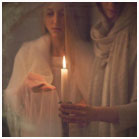|
MABON: the autumnal
equinox
(© Caillean)

Mabon is the autumnal
equinox, the time of the Second Harvest after
Lughnasadh. After cereals, now is the time of
fruits and in particular of grapes. The equinox
always falls in a different day, between 20th
and 24th September.
Equinoxes and Solstices are
not part of the great Celtic festivals, but they
surely had an important role for people with
advanced astronomical knowledge, like the Celts.
In addition, myths and customs related to these
times are present in many cultures in ancient
Europe, and the pre-Celtic megalith builders
were no doubt conscious of the power of these
days (see the alignment of sacred Circles such
as Stonehenge or Drombeg or passage tombs such
as Newgrange).
During the equinox, night
and day have exactly the same duration and this
represents a moment of balance between light and
darkness, between contrasts of opposites which
are symbolically solved.
The name Mabon comes from
the name of the Celtic God Mabon or Maponus: he
is the youth who is stolen from his mother
Modron, and is locked in a tower until King
Arthur will come to set him free. We have here a
symbolical tale which bears a strong analogy
with the myth of Persephone and Demeter, a myth
which forms the basis of the Eleusinian
Mysteries celebrated in ancient Greece between
September and October. “Mabon ap Modron” simply
means the young mother’s son and actually
represents the archetype of the Young Sun (the
Oak King in northern legends, but also
Persephone) giving way to his aspect of Old
Setting Sun (the Holly King) in the dark half of
the year and who will be reborn from the Mother
at the Winter Solstice. Just as the abducted
Persephone is led into Hades and summer comes to
an end, Mabon, too, is locked away waiting to
return.
In several neodruidic
circles this day is known as Alban Elued ‘light
of water’ as the sun sets down plunging into the
vast western seas that symbolize the otherworld.
The symbols of Mabon are
the apple, the vine and the ivy, all of them
season’s products which hide much deeper
meanings. The apple is a symbol of immortality
and of the Otherworld, while the Vine and the
Ivy grow in spirals, distinctive sign of
cyclical rebirth. Moreover, wine is produced
from the vine and the ancient people held it as
a divine gift, therefore sacred. Wine can alter
perception and bring on visions and is derived
from a long and, for those days, obscure
fermentation in dark barrels. This procedure was
later associated to initiation, to symbolic
death and transformation of the initiate. Wine
and wheat had an outstanding importance in
initiatic Eleusinian mysteries, which used to
take place in this period.
In the United States an
echo of these harvest celebrations survives in
Thanksgiving Day.
Mabon marks the beginning
of the dark half of the year, which will
culminate at Samhain….but the ancients, in their
wisdom based on deep communion with nature, well
knew that death is no more than a compulsory
passage towards rebirth….
Traduzione a
cura di Abigail_derwen
| ![]()



